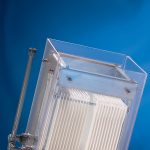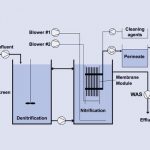The submerged membrane module for MBR applications (Bio-Cel) was developed with the objective of achieving high operational reliability combined with low capital and operational costs. Several Bio-Cel modular pilot plants are now in operation, one of which treats wastewater from a chemical park in Wiesbaden, Germany.
Stefan Krause, Ulrich Meyer-Blumenroth, Reinhard Voigt
Membrane bioreactors (MBR) are currently the primary focus of wastewater treatment technologies. MBR is a combination of a biological activated sludge process for removing nutrients and a membrane filtration process for separating biomass and treated water. MBRs have proved particularly reliable in industrial wastewater treatment. The biological degradation is the same as in a conventional activated sludge process (CAS). Most research in the field of MBR concerns understanding and minimising membrane fouling and blocking as well as ways to optimise the process (for example, in order to reduce the energy demand). The advantages of this process are a small footprint, flexibility and solids-free effluent that can be directly reused or – if purification is required – more easily conditioned compared to conventional systems. On the other hand, MBRs have a higher energy demand and require a higher level of automation, and the membranes must be cleaned regularly due to fouling and scaling.
The most energy-efficient choice is submerged membrane modules (Figure 1), where the modules are submerged directly into the activated sludge tank. Fouling control is achieved by means of an air scour on the membrane surface with additional (coarse) bubble aeration (= cross-flow aeration). The necessary shear velocity is created by the movement of the bubbles close to the membrane surface.
Wastewater characteristics and pilot plant design
The wastewater at the chemical park is discharged by more than 80 companies in the pharmaceutical industry as well as an electric chemical company and methyl cellulose, offset printing, dye, synthetic resin and polymer membrane manufacturers. Overall, the wastewater is heterogeneous and contains solvents, methyl cellulose and pharmaceutical residues, pigment remainders, nitrates, nitrides and other salts. The chemical oxygen demand (COD) of the effluent is about 4,700 mg/l (±1,000 mg/l).
The chemical wastewater is pumped from the primary sedimentation into the pilot plant following neutralisation. The treatment steps in the pilot MBR are fine screening (0.5 mm), denitrification (4 m³) and nitrification (8 m³). The total tank volume is about 12 m³. The membrane module, which has an active surface area of 60 m², is submerged into the nitrification tank. The plant is equipped for chemical cleaning. The permeate is discharged back into the WWTP. Figure 2 is a schematic diagram of the pilot plant.
Membrane and module
The choice of materials at the development stage was particularly important, as they must be chemically and mechanically resistant as well as easy to handle. Microdyn-Nadir therefore selected a polyether sulphone (PES) membrane, with a pore size of approximately 0.04 µm. Flat membrane sheets are used to prevent braiding of the membranes and ensure optimum hydraulic conditions alongside them. The major innovation of this module is the back-flushable flat membrane sheet. This back-flush ability is facilitated by laminating the PES membrane and the polyester drainage layer. The principal challenge was to create a sufficient adhesion force between the two layers while at the same time maintaining high water permeability. A low specific weight and high packing density were achieved using the specially developed, just 2 mm thick membrane sheets instead of a plate supporting system. The pressure loss inside the membrane must be low insofar as this is permitted by the design. A new drainage scheme was consequently elaborated and permeate suction takes place from the middle of the membrane.
Results
The mixed liquor suspended solids (MLSS) content was about 12,000 mg/l during the test phase. The initial permeability was approximately 280 l/(m²·h·bar). It decreased to around 50 l/(m²·h·bar) and stayed constant at this level without any cleaning. The filterability is very low because the wastewater contains methyl cellulose. Labora-tory tests were performed to determine filterability. The filtration index after 10 minutes filtration is about 0.17 (referred to clean water). Another pilot test sludge from a municipal application has a filtration index of around 0.68, in other words the sludge from the chemical park has only a quarter of the filterability of the municipal activated sludge. The flux is therefore within the expected range of approximately 8 l/m²/h.
During the investigation the inflow COD was about 4,700 mg/l (daily load of 55 kg/d with significant fluctuations). The pilot plant was operated at a sludge load of 0.4 kgCOD/kgMLSS·d-1 with a MLSS concentration of about 12 kg/m³. The volumetric loading rate is between 1 and 5 kgCOD/(m³·d).
The average COD elimination is about 60 % due to the low aerobic biodegradable wastewater composition (e.g. high level of methyl cellulose). This value is comparable to the full-scale wastewater treatment plant.
The energy demand for the two aeration systems (oxygen supply and fouling control) can be easily calculated. According to Pöpel, the specific energy demand is 5.4 Wh per m³N aeration capacity and metre depth of submergence. The energy demand for the oxygen supply is 0.2 kWh/m³ because the cross-flow aeration system is very effective as regards oxygen transfer capacity. The energy demand for fouling control is about 0.7 kWh/m³. The total energy demand for both aeration systems is thus in the region of 1.0 kWh/m³. Overall, it was possible to demonstrate that the Bio-Cel module operates efficiently despite the complicated wastewater composition.
cpp 423
Bio-Cel modules from Microdyn-Nadir
Share:








